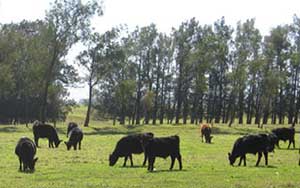Home grown beef initiative a success

Cattle must be kept home and grass fed for beef to be commercially viable in Hawai‘i, so ranchers must become grass farmers, observes Hawai‘i County Extension Agent Michael DuPonte. Little wonder the
Hawai‘i Beef Initiative drew a cross disciplinary team of CTAHR talent, including agents, specialists, researchers from
Human Nutrition, Food and Animal Sciences.
Soil and plant experts worked to remediate sugarcane and pineapple land, improve forage, and control toxic fireweed. Animal scientists addressed herd management and taught ranch hands artificial insemination techniques. Food scientists focused on carcass quality and meat packaging. Economist Linda Cox evaluated operation costs and markets.
Ultimately, says DuPonte, “genetics is the tool to improve the herd,” improving calf performance through breeding. Molokai Ranch provided 800 head to start a new Mealani herd. Sustainability-minded Ulupono Initiative helped fund meticulous monitoring of DNA markers. Within a few years, the cattle were demonstrating the best traits of parent breeds—efficient feeding Hereford and hardy, high quality Angus.
“At the end of seven years, we saw carcass quality unheard of for grass-fed beef at 26 months,” DuPonte says. Studies suggested that pasture-finished beef, though not as tender as feedlot-finished meat, satisfied consumers. With CTAHR's help, Hawaiian Red Veal marketed by the Hawai‘i Cattle Producers Cooperative Association, was named Best Local Meat by Honolulu Magazine.
The markets agreed: 11,600 grass-fed head (24 percent of the state’s cattle marketings) were locally sold in 2012. Whole Foods Market reported that Maui Cattle Company accounted for 39 percent of its total beef sales in 2012.
After generating 24 grants; producing 31 articles, abstracts, and CTAHR publications; and popularizing Mealani’s Taste of Hawaiian Range, the Hawai‘i Beef Initiative officially ended in 2008, but support for ranchers continues. Drought and competition with biofuels for land continue to be challenges, but DuPonte also sees potential markets for Hawai‘i cattle and their genetics in China.
—From CTAHR in Focus, January 2014
 UPDATE
UPDATE: Michael DuPonte received CTAHR's Award for Excellence in Extension during the college's 26th Annual Awards Banquet May 9, 2014, for his work with cattle and other projects, including an odorless piggery litter system, easy backyard chicken coops and waste management protocols for farms and slaughterhouses.